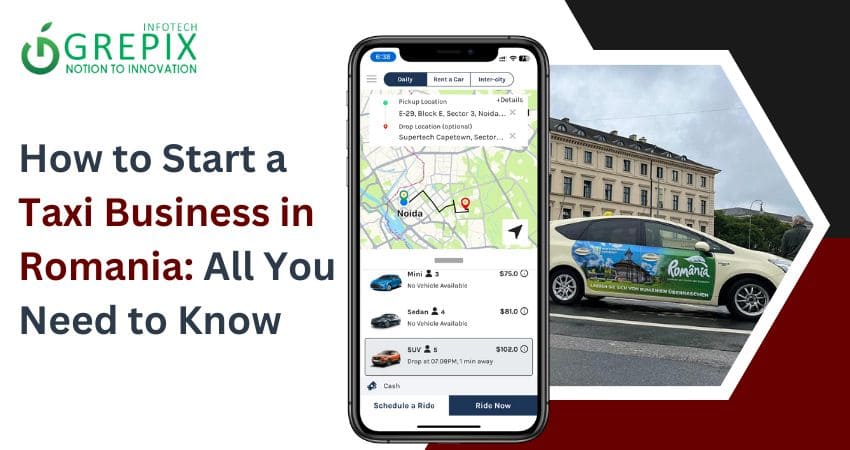How to Start a Taxi Business in Romania: All You Need to Know
Think about starting a taxi business in Romania. It’s a promising venture, given the country’s growing urban centers, increasing tourism, and high demand for reliable transportation. From the bustling streets of Bucharest to the charming city of Cluj-Napoca, there’s no shortage of potential customers. However, succeeding in this competitive market requires proper planning, compliance with local regulations, and smart business strategies.
Launching a taxi business in Romania is a rewarding yet challenging endeavor. By understanding the market, creating a detailed business plan, and complying with legal requirements, you can set yourself up for success. Remember to focus on customer satisfaction and adaptability to stand out in this competitive market. Whether catering to tourists or locals, a well-executed strategy can help you thrive in Romania’s transportation industry.
Let’s dive into a step-by-step guide to get your taxi business up and running in Romania.
Starting a taxi business in Romania is a promising opportunity due to the country’s growing urbanization, booming tourism, and high demand for reliable transportation. Cities like Bucharest and Brașov offer substantial customer bases, from daily commuters to tourists. Success requires careful planning, a solid business model, and compliance with legal regulations. Building a well-maintained fleet, hiring skilled drivers, and leveraging technology like mobile apps and GPS systems are essential for operational efficiency. By focusing on customer satisfaction, creating a strong online presence, and offering unique services, you can thrive in Romania’s competitive taxi market and achieve long-term success.
1 Understanding the Taxi Business in Romania
The Demand for Taxi Services in Romania
Romania’s growing urbanization and expanding tourism sector make it an attractive market for taxi services. Cities like Bucharest, Constanța, and Brașov see high demand for transportation, especially from tourists, daily commuters, and event-goers. Additionally, the country’s airport hubs generate significant business opportunities for taxi services. Whether you’re targeting local passengers or international visitors, there’s a steady market for reliable transportation.
Competition in the Market
Like many countries, Romania’s taxi market faces competition from ride-hailing services like Uber and Bolt. However, licensed taxi businesses still hold an advantage among customers who prioritize safety, fair pricing, and professional drivers. By offering excellent customer service and a well-maintained fleet, you can carve out a niche for yourself in this competitive industry.
2 Creating a Solid Business Plan
Choosing the Right Business Model
Deciding on your business model is the first step. You can own and manage your fleet or lease vehicles to drivers under your brand. Alternatively, you might offer private hire services for specific events or corporate clients. Define your goals and resources clearly to determine which model aligns with your vision.
Financial Projections and Budgeting
Starting a taxi business in Romania requires an upfront investment, including the cost of vehicles, licenses, insurance, and office setup. It’s also essential to account for ongoing expenses such as fuel, maintenance, and driver salaries. Develop a realistic budget and calculate potential profits to ensure the financial viability of your business.
Targeting Your Market
Who are your ideal customers? Tourists, locals, or corporate clients? For example, if you’re based in a tourist-heavy city like Brașov, airport transfers and sightseeing packages might be lucrative options. Knowing your audience will help you tailor your services and marketing strategies effectively.
3 Meeting Legal and Regulatory Requirements
Registering Your Business
In Romania, you can register your business as a PFA (Sole Proprietor), SRL (Limited Liability Company), or other legal entity. Each has advantages, but most taxi businesses operate as SRLs to limit personal liability. You’ll also need to register for VAT if your earnings exceed the threshold.
Obtaining Taxi Licenses
Taxi licenses are issued by local city halls or municipal authorities. Requirements include a clean criminal record, proof of vehicle ownership or leasing agreements, and compliance with emission standards. Some cities may limit the number of licenses, so plan accordingly.
Vehicle and Driver Regulations
Your vehicles must meet strict standards for safety, comfort, and environmental compliance. Similarly, drivers must hold valid licenses, pass background checks, and, in some cases, complete customer service training. Ensuring compliance with these rules is non-negotiable for your business’s success.
4 Building and Managing Your Fleet
Choosing the Right Vehicles
Selecting the right vehicles is a crucial decision. Look for models that balance affordability, durability, and passenger comfort. Eco-friendly vehicles, such as hybrids or electric cars, can help reduce operating costs and align with Romania’s environmental goals.
Maintenance and Insurance
To keep your fleet running smoothly, implement a regular maintenance schedule. Comprehensive insurance coverage is mandatory and should include third-party liability, accidents, and theft protection.
5 Setting Up Operations
Establishing a Dispatch System
Invest in GPS technology and a reliable dispatch system to manage bookings efficiently. You might also consider creating a mobile app for your business to attract tech-savvy customers. If that’s outside your budget, partnering with an existing platform like Bolt or Free Now could be a practical solution.
Hiring and Training Drivers
Recruiting skilled drivers is essential to delivering top-notch service. Ensure they have clean driving records and a customer-friendly attitude. On local routes, language skills (for tourists) and professional conduct can give your business a competitive edge.
Also Read: "Unveiling the Romanian Top 10 Taxi Apps for Modern Mobility"
6 Marketing Your Taxi Business
Building an Online Presence
In Romania, having a strong online presence can set your taxi business apart. Start by creating a professional website where customers can easily book rides, check rates, and learn more about your services. Include features like live chat and FAQs to improve user experience. Social media platforms like Facebook and Instagram are excellent for showcasing customer testimonials, promotions, and updates. Don’t forget to list your business on Google Maps and local directories so customers can find you quickly.
Partnering with Local Businesses
Collaborating with local hotels, travel agencies, and event planners can help you secure a steady stream of clients. For instance, you could offer airport transfers for tourists staying at nearby hotels or provide transportation for weddings and corporate events. Building relationships with local businesses not only increases visibility but also creates long-term partnerships.
Customer Retention Strategies
Providing a memorable customer experience is key to building loyalty. Offer incentives like loyalty programs or referral discounts to keep customers coming back. Additionally, get riders' opinions to determine what needs to be improved. Small gestures like offering water bottles or free Wi-Fi in your taxis can leave a lasting impression and encourage repeat bookings.
7 Challenges in the Romanian Taxi Market
Navigating Competition
Competing with ride-hailing services like Uber, Bolt, and Free Now can be challenging. To stand out, emphasize the advantages of your licensed taxi service, such as transparent pricing, professional drivers, and enhanced safety. Highlighting these benefits in your marketing campaigns can help attract customers who value reliability.
Handling Seasonal Fluctuations
Romania’s taxi market is often affected by seasonal demand, especially in tourist-heavy areas like Brașov or Constanța. During peak times, ensure enough drivers and vehicles to handle the rush. In quieter seasons, focus on locals by offering discounted fares or loyalty programs to sustain steady business.
8 Scaling and Growing Your Taxi Business
Expanding Your Fleet
As your taxi business grows, consider adding more vehicles to your fleet. Expanding your services to neighboring cities or rural areas can also open new revenue streams. Investing in electric or hybrid taxis is another great way to reduce costs and meet growing environmental expectations.
Diversifying Revenue Streams
To grow your income, think about diversifying your services. For instance, you could introduce luxury car options for special events or provide long-distance travel services for tourists. Another option is to develop your mobile app for direct bookings, enabling you to compete with established ride-hailing platforms.
Conclusion
Starting a taxi business in Romania offers immense potential, with its growing urbanization, booming tourism, and demand for reliable transportation. Success requires a well-planned approach, from complying with local regulations to implementing innovative strategies for customer satisfaction and operational efficiency.
At Grepix Infotech, we specialize in cutting-edge taxi app development tailored to your business needs. Our solutions streamline bookings, enable GPS tracking, and offer seamless cashless payments, ensuring your business stands out in Romania's competitive market. Partner with Grepix Infotech to transform your vision into a thriving taxi business, delivering exceptional service and driving long-term success. Let’s build your future together!
FAQs
1. What are the costs of starting a taxi business in Romania?
Starting costs include purchasing or leasing vehicles, acquiring licenses, and insurance, and setting up a dispatch system. On average, initial investments range from €10,000 to €30,000 depending on the size of the fleet.
2. How long does it take to get a taxi license in Romania?
The process can take several weeks to months, depending on the municipality. Ensure you have all required documents and meet local requirements to avoid delays.
3. Can a foreigner start a taxi business in Romania?
Yes, but you must have a valid residence permit and comply with local business registration laws. Collaborating with a local advisor can simplify the process.
4. What are the legal requirements for a taxi business in Romania?
Vehicles must pass regular inspections, meet emission standards, and be equipped with a taximeter and a GPS system. They also need to display the taxi license number prominently.
5. How can I compete with ride-hailing services like Uber and Bolt?
Focus on offering reliable service, transparent pricing, and excellent customer care. Partnering with local businesses and emphasizing the safety and professionalism of licensed taxis can also give you an edge.
Looking out to start your own venture like Uber? Try out our HireMe Taxi Uber Clone, the easiest way to kick-start your taxi business.








